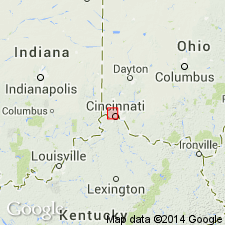
- Usage in publication:
-
- Miamitown Shale
- Modifications:
-
- Named
- Dominant lithology:
-
- Shale
- AAPG geologic province:
-
- Cincinnati arch
Summary:
Named Miamitown Shale for Miamitown, Hamilton Co, OH. Composed of shale and mudstone with a few thin, widely spaced limestone interbeds. Recorded thickness range is 5 to 30 ft. Underlain by the Fairview Formation, overlain by Bellevue Limestone.
Source: GNU records (USGS DDS-6; Reston GNULEX).
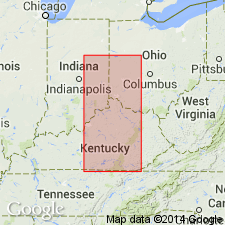
- Usage in publication:
-
- Miamitown Shale*
- Modifications:
-
- Overview
- AAPG geologic province:
-
- Cincinnati arch
Summary:
Miamitown Shale adopted for use by USGS.
Source: GNU records (USGS DDS-6; Reston GNULEX).
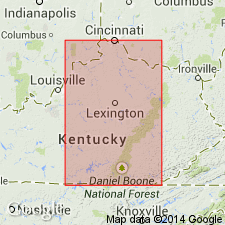
- Usage in publication:
-
- Miamitown Shale Member*
- Modifications:
-
- Revised
- AAPG geologic province:
-
- Cincinnati arch
Summary:
The Miamitown is reduced in rank to the Miamitown Shale Member of the Fairview Formation in north-central KY. Age is Late Ordovician (Cincinnatian and Maysvillian). The Miamitown Shale remains in good usage in southwestern OH.
Source: GNU records (USGS DDS-6; Reston GNULEX).
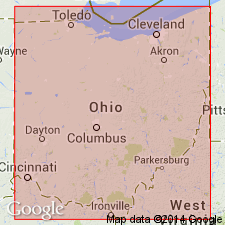
- Usage in publication:
-
- Miamitown Shale
- Modifications:
-
- Revised
- AAPG geologic province:
-
- Cincinnati arch
Summary:
The Geological Survey of Ohio recognizes the Cincinnati Group proposed by Meek and Worthen (1865), but at this time retains it as an informal term. The unit will be formally reinstated as a lithostratigraphic term after revision of its lower boundary and minor lithologic redescription of its units are completed. The ten formations included in the group are the (ascending) Clays Ferry Formation, the Kope Formation, the Fairview Formation, the Miamitown Shale, the Grant Lake Limestone, the Arnheim Formation, the Waynesville Formation, the Liberty Formation, the Whitewater Formation, and the Drakes Formation. Six members have been identified in the course of field mapping: the Point Pleasant Tongue of the Clays Ferry, the informal Bellevue, Corryville, Mount Auburn, and Straight Creek members of the Grant Lake Limestone, and the Preachersville Member of the Drakes Formation. The Backbone Creek and Elk Creek beds are recognized as excellent stratigraphic marker beds.
Source: GNU records (USGS DDS-6; Reston GNULEX).
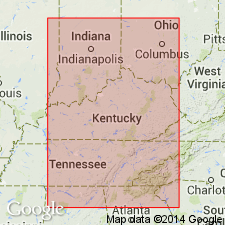
- Usage in publication:
-
- Miamitown Shale*
- Modifications:
-
- Overview
- AAPG geologic province:
-
- Cincinnati arch
Summary:
The Miamitown Shale in southwestern OH consists of shale and mudstone with minor interbeds of limestone. Fossils within this unit include gastropods and pelecypods. Thickness is 5 to 35 feet. Conformably overlies the Fairview Formation and underlies the Bellevue Limestone. The Miamitown is of Late Ordovician age.
Source: GNU records (USGS DDS-6; Reston GNULEX).
For more information, please contact Nancy Stamm, Geologic Names Committee Secretary.
Asterisk (*) indicates published by U.S. Geological Survey authors.
"No current usage" (†) implies that a name has been abandoned or has fallen into disuse. Former usage and, if known, replacement name given in parentheses ( ).
Slash (/) indicates name conflicts with nomenclatural guidelines (CSN, 1933; ACSN, 1961, 1970; NACSN, 1983, 2005, 2021). May be explained within brackets ([ ]).

